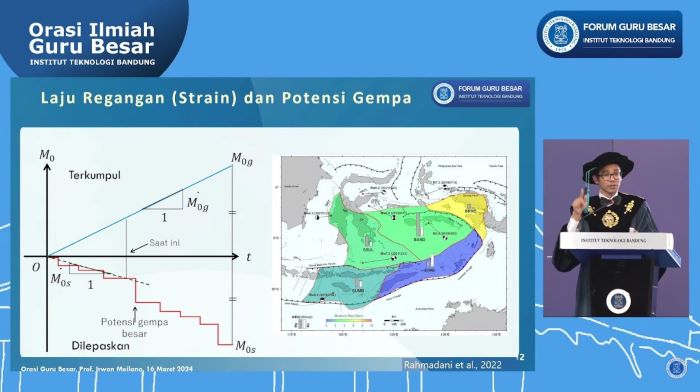Scientific Speech by Prof. Irwan Meilano: The Importance of Understanding Earthquake Sources to Save More Lives
By M. Naufal Hafizh, S.S.
Editor M. Naufal Hafizh, S.S.

BANDUNG, itb.ac.id — Prof. Dr. Irwan Meilano, S.T., M.Sc., delivered a Distinguished Professor’s Speech on Saturday (16/03/2024) at the West Hall of Institut Teknologi Bandung. The speech was titled “Understanding Earthquake Sources, Reducing Disaster Risks” and was presented by Prof. Irwan.
Born on May 18, 1974, Prof. Irwan earned his bachelor's degree in Geodetic Engineering in 1997. He then pursued his master's and doctoral studies in the same field at Nagoya University, Japan, completing them in 2006. An enthusiast of long running and long riding, he has been the Dean of the Faculty of Earth Science and Technology (FEST) at ITB since 2020. His research focus is on earthquakes. Prof. Irwan is prolific, having published 159 Scopus-indexed international publications, authored 5 ISBN-registered reference books, received funding for 20 research projects, and holds 3 copyrights.
In his speech, Prof. Irwan illustrated that every year, Indonesia suffers significant losses due to natural disasters. Over the last 42 years, the greatest losses have been caused by earthquakes and tsunamis, amounting to Rp6.16 trillion. Unfortunately, earthquakes cannot yet be predicted like weather forecasts.
"Although we cannot yet predict earthquakes, we can quantify the potential and long-term expected rate of earthquake occurrences, estimate their strength for early warning systems, and estimate future seismic acceleration values/PSHA (Probabilistic Seismic Hazard Analysis) and their risks," he stated. This aligns with the role of geodesy in tectonic studies to understand earthquake cycles as well as transient and instantaneous deformations.
In 2018, Prof. Irwan, along with his doctoral students and other researchers, managed to calculate the strain rate and map earthquake potentials in eastern Indonesia. "The results mapped earthquake accumulations in the Ambon, NTT, and Bird's Head regions of Papua. The findings were validated by the Ambon 2019 earthquake of 6.5 magnitude and the Flores Sea earthquake in 2021 with a magnitude of 7.4. However, no earthquakes have yet shaken the Bird's Head area. Hopefully, it will not occur, but we must remain vigilant," he said.
Prof. Irwan used the analogy that if one wants to shop, one must first save money. "We are able to see areas that are still saving (storing potential earthquakes/stress) from their tectonic movements and areas that have already spent (strain rate). The gap between the savings value and the amount spent is presented in a histogram to make it easier to understand. From there, we map areas that have been saved but not yet spent. We calculate which areas are increasing in stress but have not yet experienced an earthquake," he explained.
Moreover, geodesic data is also useful for early earthquake warning systems. Prof. Irwan, through his research with the Meteorology, Climatology, and Geophysics Agency (BMKG), calculated rapid magnitude estimates for the 2018 Lombok and Palu earthquakes. The results are promising as a complement to the early warning system. Not only calculating their strength, Prof. Irwan also calculated the moment tensors to determine the tsunami potential of the resulting earthquakes.
The multidisciplinary research collaboration undertaken by Prof. Irwan in the past three years not only addresses earthquake sources but also explores their hazards and vulnerabilities.
"Thorough and accurate research on earthquake sources is not just an academic achievement, but serves to reduce disaster risks. Understanding these earthquake sources provides real benefits to the community and contributes significantly to policymaking. There is a need to develop more effective risk mitigation strategies, design more earthquake-resistant infrastructure, and ultimately save more lives and reduce economic losses," said Prof. Irwan.
Reporter: Maharani Rachmawati Purnomo (Oceanography, 2020)
Translator: Anggi Nurdiani (Management, 2024)
Editor: Hanifa Juliana (Urban and Regional Planning, 2020)

.jpg)
.jpg)
.jpg)
.png)
.jpg)

